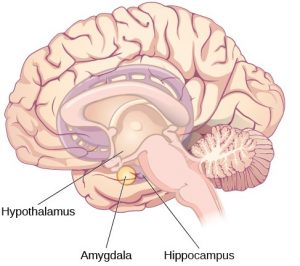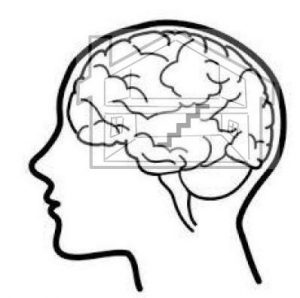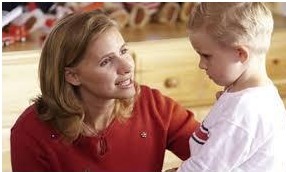The parts of the brain that effect Our Psychology, Emotions and Behaviors
 The brain is the most important and complex organ in our bodies. You don’t have to be a brain specialist though to appreciate some of the basics about the brain’s role in emotions and behaviors in both ourselves and our children.
The brain is the most important and complex organ in our bodies. You don’t have to be a brain specialist though to appreciate some of the basics about the brain’s role in emotions and behaviors in both ourselves and our children.
The brain is compartmentalised for our understanding but in reality all the parts work in complex, intertwined ways. The largest section of the brain and closest to the surface is the Cerebrum (suh-REE-bruhm) or Cortex. This is often broken down into lobes or sections of the brain: the frontal lobe, parietal lobe, temporal lobes, and occipital lobe. The frontal lobe is at the front of the head and is responsible for planning, organisation, logical thinking, reasoning, and managing emotions. This is the part you will hear about most regarding the expression and regulation of emotions and behaviors. It is also known as the “higher brain”, “rational brain”, or the “upstairs brain”.
 If we then jump to the centre of the brain, we find some strangely named parts that play a big role in emotions. The Amygdala (uh-MIG-duh-luh) is a group of cells that interprets the emotional meaning of everything that happens to you. If the amygdala interprets something as threatening, it sends messages to another structure called the Hypothalamus (HI-pO-thal-a-mus), which controls the release of hormones into the body to get you ready for a fight-or-flight response. The fight-or-flight response is what happens when our bodies tense up, become more alert, and ready for action to either escape (flight) or defend ourselves (fight). Finally, another structure called the Hippocampus (hip-uh-KAM-pus), organises memories so the amygdala can interpret an event. These three structures are part of what we call the “emotional brain” or “downstairs brain” and activate strong emotions and urges. This part of the brain can over react sometimes (think of a child in a tantrum, or even our own reaction when the kids start fighting with each other) so needs a helping hand from the “rational brain” frontal lobes to settle down.
If we then jump to the centre of the brain, we find some strangely named parts that play a big role in emotions. The Amygdala (uh-MIG-duh-luh) is a group of cells that interprets the emotional meaning of everything that happens to you. If the amygdala interprets something as threatening, it sends messages to another structure called the Hypothalamus (HI-pO-thal-a-mus), which controls the release of hormones into the body to get you ready for a fight-or-flight response. The fight-or-flight response is what happens when our bodies tense up, become more alert, and ready for action to either escape (flight) or defend ourselves (fight). Finally, another structure called the Hippocampus (hip-uh-KAM-pus), organises memories so the amygdala can interpret an event. These three structures are part of what we call the “emotional brain” or “downstairs brain” and activate strong emotions and urges. This part of the brain can over react sometimes (think of a child in a tantrum, or even our own reaction when the kids start fighting with each other) so needs a helping hand from the “rational brain” frontal lobes to settle down.
Ok, now we are familiar with some of the major parts of the brain involved in behaviours and emotions we can look at how they interact with each other and influence behaviors through development, how we can help our kids understand what is happening, and what we can do to help our kids (and ourselves) to better manage behaviors and emotions.
When a child is born their brain size is only 25% of what it will be as an adult. The main structures are all there, but the connections between them – the brain wiring – is still very sparse, especially in the upstairs, rational brain (cerebrum). The first five years of life sees over 90 percent of the brain’s growth occurring with the formation of the connections directly linked to a child’s life experiences and emotional interactions with others. What that means is, every time we experience something, our brains form a connection between the cells and structures about memories, emotional reactions, and skill learning. Then, every time we have the same or similar experience, those connections become stronger…we are learning.
How downstairs brain and the upstairs brain
Let’s have another look at the emotional, downstairs brain and the rational, upstairs brain. The downstairs brain is the part of our brain that makes us act without thinking. It has to do this quickly for survival purposes – if you are in a life threatening situation you don’t have time to sit down and draw up a plan of action, you just need to act! Developmentally, this part of the brain is well developed at birth and forms more connections earlier than the upstairs brain because it is responsible for essential tasks such as making sure our needs are met, feeling strong emotions, using instinct to keep us safe, and managing bodily functions.
 The upstairs, rational brain whilst structurally all there (remember the lobes?) is much slower in its development of connections. This part of the brain is highly sophisticated and responsible for problem solving, rational thinking, logic, planning and decision making, organisation, and self-control. All of these things are learnt through repeated experiences. Keeping to the house analogy, the upstairs, rational brain is under major construction for the first few years of life. During adolescence, the upstairs brain gets a remodelling which takes several more years. So the upstairs brain is not fully mature until the mid-twenties!!!!
The upstairs, rational brain whilst structurally all there (remember the lobes?) is much slower in its development of connections. This part of the brain is highly sophisticated and responsible for problem solving, rational thinking, logic, planning and decision making, organisation, and self-control. All of these things are learnt through repeated experiences. Keeping to the house analogy, the upstairs, rational brain is under major construction for the first few years of life. During adolescence, the upstairs brain gets a remodelling which takes several more years. So the upstairs brain is not fully mature until the mid-twenties!!!!
Continuing with the house analogy of the brain, the upstairs and downstairs are connected by a stairway on which messengers can run up and down sharing information. In our brains, these connections are less obvious but function in a similar manner. We need the downstairs “emotional brain” to be able to inform the upstairs “rational brain” with instincts and reflexes, feelings, and information about our bodily functions such as breathing, temperature, etc. However, we also need messages going from the upstairs brain downstairs so we can moderate and make sense of the information coming from down below.
So what does all of this mean when we are dealing with emotions and behaviours? Basically, our kids (and some adults) are functioning primarily from the emotional, reactive, downstairs brain – they are going to throw a tantrum because you gave the wrong colour plate, get frustrated with their siblings, be terrified of putting her face under the water at swimming lessons, and melt into a puddle of tears at the slightest scratch on a finger. Their rational, self-controlling, upstairs brain is still learning how to manage these situations, AND the connections (i.e. stairway) between the upper and lower brains is being blocked by emotional overload so very little problem solving and effective decision making can occur.
Having some understanding of the brain and how it affects our emotions and behaviors is useful both for parents and our children. It can be very confusing and scary at times when our kids experience strong emotions and don’t yet know how to predict them, manage them and calm down from them. As parents, knowing there are parts of our children’s brains that are underdeveloped can help us respond to their emotions and behaviors in a way that supports them and helps them build connections in their brains based on positive experiences rather than punishments and disconnection.
One skill of our brains that develops fairly early is the use of imagination, so when talking with kids about the brain, emotions and behaviors, we can get creative. In our last blog we talked about the brain as a “house” with a downstairs (emotional brain) and upstairs (thinking brain) connected by a staircase so messages can be passed between the two. Hazel Harrison (2015) a Clinical Psychologist suggests adding characters within the brain house such as Big Boss Bootsy from downstairs who sounds the alarm when there is a threat and blocks the stairway (called Flipping the lid by Daniel Siegel, 2010) so the upstairs brain characters can’t slow things down while the downstairs characters are working to keep us safe. The upstairs characters meanwhile, work on problem solving, calming down, and making good choices. The brain works best when both upstairs and downstairs work together so we can stay safe and make good choices without overreacting.
 Creating Brain characters – A strategy used by child psychologists to help children understand and manage emotions
Creating Brain characters – A strategy used by child psychologists to help children understand and manage emotions
Help kids come up with their own names for characters in the brain. It doesn’t matter what they are called as long as both you and your child know who you are referring to and what they do (refer to Harrison, 2015 for more ideas). You can share stories about the brain characters and their antics based on real life experiences of both your child and yourself, e.g. “Remember when Big Boss Bootsy took over and made you hit your brother before you even had time to think?” Or “I think Alerting Allie and Big Boss Bootsy made Mummy feel cranky this morning when we were running late for school. Lucky Calming Carl was able to settle things down before they flipped my lid!”
Using the brain house and its character inhabitants helps kids talk about their emotions and related behaviors in a non-judgemental, no blame, fun way because it separates their feelings, thoughts and behaviors from the child. Some parents raise concerns about kids using this as an excuse for their behaviors, and not taking responsibility for their actions. If we jump straight into consequences though, we are trying to reason with the rational (upstairs) brain of our child, whereas they are perceiving our response as a threat and functioning from the emotional (downstairs) brain, with a huge likelihood that the stairway has been blocked and all rational thoughts locked in.
Teaming up with our kids to manage the brain characters helps our kids to identify when things go wrong, and feel they can talk about them with you in a safe, non-confrontational way. You and your kids can then be calm enough to access the rational brain and work out ways to manage the characters better in future. You can also call on characters to help out, e.g. When we try to problem solve with our child and they just respond with “don’t knows” we can ask them what they think Problem Solving Pete (and upstairs brain character) may suggest.
When our kids are stuck in their downstairs brain, it helps for parents to point that out and name what you think is going on. For example, “You seem really sad that your friend doesn’t want to play with you today”. This is validating your child’s emotions – letting them feel they are understood – so your child doesn’t have to stay stuck with the strong emotions of the downstairs brain. Once your child feels heard, he is more likely to be able to re-open the stairway to the upstairs brain and work with you on problem solving or making choices about the situation.
To know more about behavior and emotions you can visit: www.changespsychology.com.au
Sources:
Deak, J. (2010). Your Fantastic Elastic Brain – Stretch it, shape it. Little Pickle Press LLC, Belvedere CA.
Harrison, H (2015). How to teach your kids about the brain. http://www.thinkavellana.com/new-blog/2015/11/23/how-to-teach-your-kids-about-the-brain
Schwarz, N( 2016). What anxious and angry kids need to know about their brain.
https://imperfectfamilies.com/what-anxious-and-angry-kids-need-to-know-about-their-brain/
Siegel, D. & Payne Bryson, T. (2012). The Whole-brain child. Bantam Books, New York.
Sunderland, M (2006). The Science of Parenting. Dorling Kindersley Limited, London.
Harrison, H (2015). How to teach your kids about the brain. http://www.thinkavellana.com/new-blog/2015/11/23/how-to-teach-your-kids-about-the-brain
Schwarz, N( 2016). What anxious and angry kids need to know about their brain.
https://imperfectfamilies.com/what-anxious-and-angry-kids-need-to-know-about-their-brain/
Siegel, D. & Payne Bryson, T. (2012). The Whole-brain child. Bantam Books, New York.
Harrison, H (2015). How to teach your kids about the brain. http://www.thinkavellana.com/new-blog/2015/11/23/how-to-teach-your-kids-about-the-brain
Schwarz, N( 2016). What anxious and angry kids need to know about their brain.
https://imperfectfamilies.com/what-anxious-and-angry-kids-need-to-know-about-their-brain/
Siegel, D. & Payne Bryson, T. (2012). The Whole-brain child. Bantam Books, New York.
Harrison, H (2015). How to teach your kids about the brain. http://www.thinkavellana.com/new-blog/2015/11/23/how-to-teach-your-kids-about-the-brain
Schwarz, N( 2016). What anxious and angry kids need to know about their brain.
https://imperfectfamilies.com/what-anxious-and-angry-kids-need-to-know-about-their-brain/
Siegel, D. & Payne Bryson, T. (2012). The Whole-brain child. Bantam Books, New York.
Harrison, H (2015). How to teach your kids about the brain. http://www.thinkavellana.com/new-blog/2015/11/23/how-to-teach-your-kids-about-the-brain
Schwarz, N( 2016). What anxious and angry kids need to know about their brain.
https://imperfectfamilies.com/what-anxious-and-angry-kids-need-to-know-about-their-brain/
Siegel, D. & Payne Bryson, T. (2012). The Whole-brain child. Bantam Books, New York.


